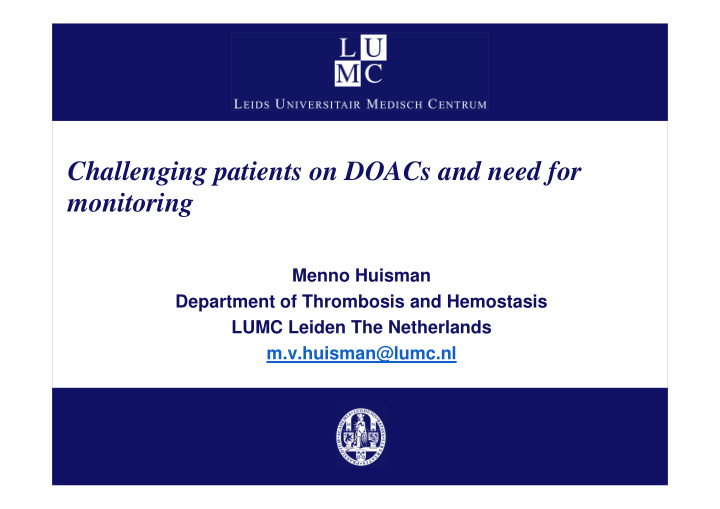



Challenging patients on DOACs and need for monitoring Menno Huisman Department of Thrombosis and Hemostasis LUMC Leiden The Netherlands m.v.huisman@lumc.nl
Conflicts of interest •Research grants from Boehringer Ingelheim, GSK and Actelion •Consulting fees from BI, Pfizer-BMS, Bayer Healthcare, Daiichi-Sankyo 2
Bleedings in RE-LY trial Moore T BMJ 2014; 349:g4517
Efficacy endpoints in RE-LY trial Connolly S et al New Eng J Med 2009; 361:1139- 1151
Guide to indication and dosing •Local protocol •EHRA practical guide – Heidbuchel et al Europace 2015;17: 1467-507 •eMA website 5
Dose adjustments found in eMC • Dabigatran: 150 mg BID; lower doses for patients at higher bleeding risk, e.g. age above 80 years, decreased renal clearance • Rivaroxaban: 20 mg OD; lower doses for patients with decreased renal clearance 6
Dose adjustments found in eMC • Edoxaban: 60 mg OD; reduced dose in patients with one or more of the following clinical factors: • Renal impairment - clearance 15 - 50 mL/min • Low body weight ≤ 60 kg • Apixaban: 5 mg BID; reduced doses for patients with two or more of the following characteristics: • age ≥ 80 years • body weight ≤ 60 kg • creatinine ≥ 133 μ mol/L 7
Clinical situation where lab testing could be useful • Bleeding patient or emergency surgery including trauma + • Extreme bodyweight (very low or very high) • Renal failure – acute situations with recent deterioration + • Thrombembolic or bleeding complications + • Prior to thrombolysis in patients with ischemic stroke + • Lupus anticoagulant testing • Antidotes – need for applying idarucizumab or andexanet and effect +
Laboratory tests • No routine lab testing needed • In acute patients screen tests (APTT, PT) mostly sufficient • Blood for peak level 3 hours after last intake of DOAC 9 9
Screen tests •Dabigatran: • APTT (completely normal - no relevant dabigatran anticoagulant activity) • If prolonged APTT, no quantitative idea •Rivaroxaban, apixaban, edoxaban: • PT (completely normal – no relevant anti-Xa activity) • If prolonged PT, no quantitative idea 10 10
APTT and dabigatran 3.6 • A 2.5-fold prolongation in aPTT correlates with 3.3 an excessive 3.0 anticoagulant effect 1,2 2.7 aPTT • Correlation is not linear, 2.4 especially at higher 2.1 concentrations 1,2 1.8 Multiple dose 1.5 y = 0.86 + 0.06873* • x 1/2 1.2 r 2 = 0.8514 0.9 0 100 200 300 400 500 600 700 800 900 1000 Dabigatran plasma concentration (ng/mL) 1 . Stangier J et al. Br J Clin Pharmacol 2007;64:292–303; 2 . Stangier J. Clin Pharmacokinet 2008;47:285–95
Sensitivity PT for rivaroxaban
Specific tests •Dabigatran • direct thrombin inhibitor test •Rivaroxaban, apixaban, edoxaban • direct Xa inhibitor test •Good quantitative information • No relevant reference values • availability 24/7 is a problem 13 13
Bleeding patient •Patient 68 years old, non valvular AF •Treatment with apixaban 5 mg BID •Presents with hematemesis (‘vomiting blood)
Bleeding management in DOACs Laboratory -PT (aPTT for dabigatran) – dTT/anti Xa tests -Hb, platelets, renal function Heidbuchel Europace 2015;17:1467 ‐ 507 15
Renal insufficiency • A 66-year-old woman developed acute diarrhea and vomiting and was admitted 4 days later in shock (70/40 mm Hg) • Rx: rivaroxaban (20 mg OD), erythromycin for urinary tract infection • Oral mucosal bleeding noted on intubation • Laboratory tests: PT 34 sec, creat. clearance 20 ml/min and signs of liver impairment, anti-Xa level: 420 ng/ml • Patient recovered upon i.v. fluid support, PCC and antibiotic treatment 16
Quote from other speaker (H ten Cate) • “Here, the lessons from VKA therapy should warn us that any form of comorbidity may have serious consequences for drug intake, absorption and metabolism, in general, certainly in the elderly.” 17 Ten Cate Thromb J 2013: 11: 8
Patient with ischemic stroke •Patient 78 years old with non valvular atrial fibrillation presents with ischemic stroke - Rx: Edoxaban 60 mg OD •Can we give thrombolytic treatment and perform thrombectomy?
•When last dose of edoxaban taken? •Perform quick lab tests •APTT, if sensitive, is useful •Not formally studied but already practice
Around applying (specific) antidotes • Idarucizumab and andexanet are specific antidotes for dabigatran and anti-Xa anticoagulant activity • Both drugs are being evaluated in: life threatening bleeding or urgent surgery with high bleeding risk • Lab testing may be useful to indicate, evaluate and titrate use of antidote 20
RESULTS: Primary endpoint in Group A by dTT Reversal of dabigatran-anticoagulation with idarucizumab Diluted thrombin time 130 120 110 100 90 Idarucizumab 2x 2.5 g dTT (s) 80 70 60 50 Assay upper 40 limit of normal 30 20 Baseline Between 10–30 1h 2h 4h 12h 24h vials min Time post idarucizumab Schulman S. Pollack et al NEJM June 2015; 373: 511- 520emost 2014;111:575-82
NOACs 22 4 februari 2013
Thoughts on routine monitoring • Within patient variability in drug levels (with dabigatran) is large: In a study (Chan N et al. JTH 2015) patients had dabigatran levels in the upper or lower quartiles at 1 month, but levels in the middle quartiles on a second determination • If the level is too high or too low, what do we do about dosing if there are limited dose formulations? • We do not know what target levels should be • We have no evidence that dose adjustment based on drug level determination improves clinical outcomes compared with unmonitored fixed dosing 23
Conclusions •Clear guidelines for indications and dosing of DOACs •No large dose regimens available •Lab testing is useful in challenging patients on DOACs 24
Recommend
More recommend